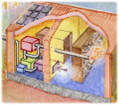
 |
Physics of low energy storage |
Tim Padfield, Morten Ryhl-Svendsen, Poul Klenz Larsen and Lars Aasbjerg Jensen
This article summarises the case for building cool storage of museum and archive items in a way which avoids air conditioning and provides simple and fail-safe climate control. This document is the basis for an invited contribution to the IIC congress in Turin. It presents condensed versions of explanations and evidence presented elsewhere on this website (conservationphysics.org).
The chemical deterioration rate of many materials is defined by quantitative theories developed in the late nineteenth century, which explained through molecular kinetics the observed exponential increase in chemical reaction rate with rising temperature.This need to keep things cool for durability is the single most powerful influence on storage design, and has long been practiced, particularly in movie film archives.
The other major influence on durability is the chemical activity of water vapour, called the relative humidity (RH) in the conservation literature. Its potency is described by the law of mass action, which for many cases gives a rate of hydrolytic reaction proportional to the RH. Therefore, only a very low RH affords significant protection.
Recent advances in building techniques, particularly in thermal insulation and in airtightness, allow us to develop a simple and cheap general principle for museum and archival storage suitable for the collections of materials which centuries of experience tell us are durable in the ordinary climate on earth.
The low energy storage principle is simply stated, and equally simply achieved in practice. A lightweight, thermally insulated, airtight building is put on top of an uninsulated floor slab laid directly on the ground, whose immense thermal capacity makes a heavy building unnecessary. The thermal insulation is calculated to even out the daily temperature cycle but not to prevent an annual temperature cycle which is about half the amplitude, but much smoother, than the annual temperature cycle outside.
The winter temperature in the store will nearly always be above ambient and so will maintain a moderate RH without need for either humidification or dehumidification. The temperature in summer will be below ambient and thus force dehumidification as warm air of high water vapour concentration filters in. However, the airtightness of the building allows intermittent dehumidification with low energy consumption, less than one kWh/m3 per year. This energy can be provided by solar panels, covering only a portion of the roof of the building. It can also be provided from the grid through smart meters which only let electricity through when the wind turbines are spinning, so there is no carbon dioxide penalty.
There now exist enough buildings designed on this principle to reassure curators that highly valued collections can be stored in a space with a gentle temperature cycle that has not been demonstrated to cause damage and with a RH stability that is better than air conditioning usually achieves.
One important hindrance remains: curators and managers will not lightly go against the advice, or the instructions of museum and archive standards. These standards have relaxed considerably in recent years but some continue to give precise limits to permitted temperature ranges which, if obeyed rigorously, require orthodox air conditioning.
The lowest temperature which can be achieved by entirely passive means, using no energy, is the annual average temperature where the store is situated.
An economic and simple solution is to allow a slowly varying temperature following the seasons, without explicit temperature control.

An annual temperature cycle well within the outdoor running average temperature has not been found to damage most artefacts (some exceptions are discussed later). However, the summer temperature in the store will generally be below ambient. This will cause the relative humidity (RH) to rise above ambient. Summer dehumidification will be necessary. The low point of the temperature cycle in winter can be adjusted to make humidification unnecessary. This is achieved through calculation of the insulation thickness in the walls and ceiling, leaving the floor uninsulated. Over a period of a few years the floor will achieve equilibrium with the building interior and will function as a passive temperature moderator.
This storage principle requires a very large heat storage capacity and also benefits from humidity buffering, though this is not essential. Humidity buffering requires a very low air exchange rate but it allows intermittent dehumidification, so the energy for the dehumidifier can be provided by solar voltaic panels on the roof, whose output is only needed during the bright summer days.
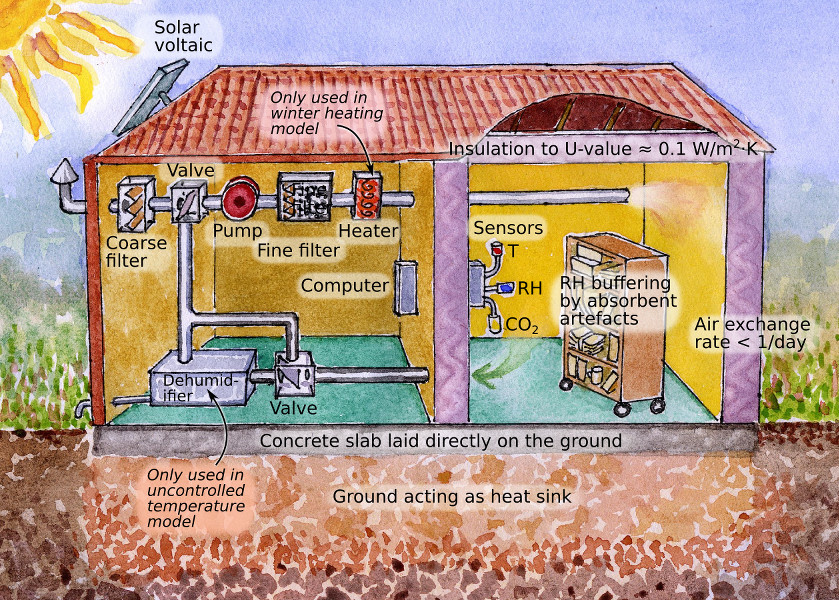
Figure 2: The principle of operation of low energy storage. Temperature control is entirely passive, through the immense heat capacity of the ground below the uninsulated floor and the good insulation (low U–value) of the building walls and roof. RH control is by summer dehumidification only. The air is re-circulated at about 0.2 air changes per hour through a single duct to the remote end of the space. The return air is recirculated either through the dehumidifier, or bypassing the dehumidifier. The outside air pump only operates when, by chance of the weather, the outside air is of suitable water vapour content to drive the interior towards its target RH.
The heater is only installed, instead of the dehumidifier, in the alternative, moderately-low energy storage method using winter heating, as described later.
A powerful reason to promote this drifting temperature model for storage of historic artefacts is the increase in durability that comes from reducing the temperature below the human comfort zone. Without active control, the average temperature in the store can be brought to a value just a degree or two above the yearly average outdoor temperature.
The widely valid exponential increase of reaction rate with increasing temperature was established empirically in the late nineteenth century by Svante Arrhenius and then explained in terms of molecular collision theory by Ludvig Boltzmann (please consult Wikipedia for references to the historic science). The effect is powerful. Reducing the temperature by eight degrees will give a reaction rate about one quarter of that in a human-comfortable room. This is roughly what can be achieved in the north temperate zone by allowing a storage space to drift in temperature towards the running average outside temperature while remaining within half the temperature span of the monthly averages.
The optimal geographical range for this climate control system is regions with an annual average temperature below 15 °C. This range is shown in figure 3.
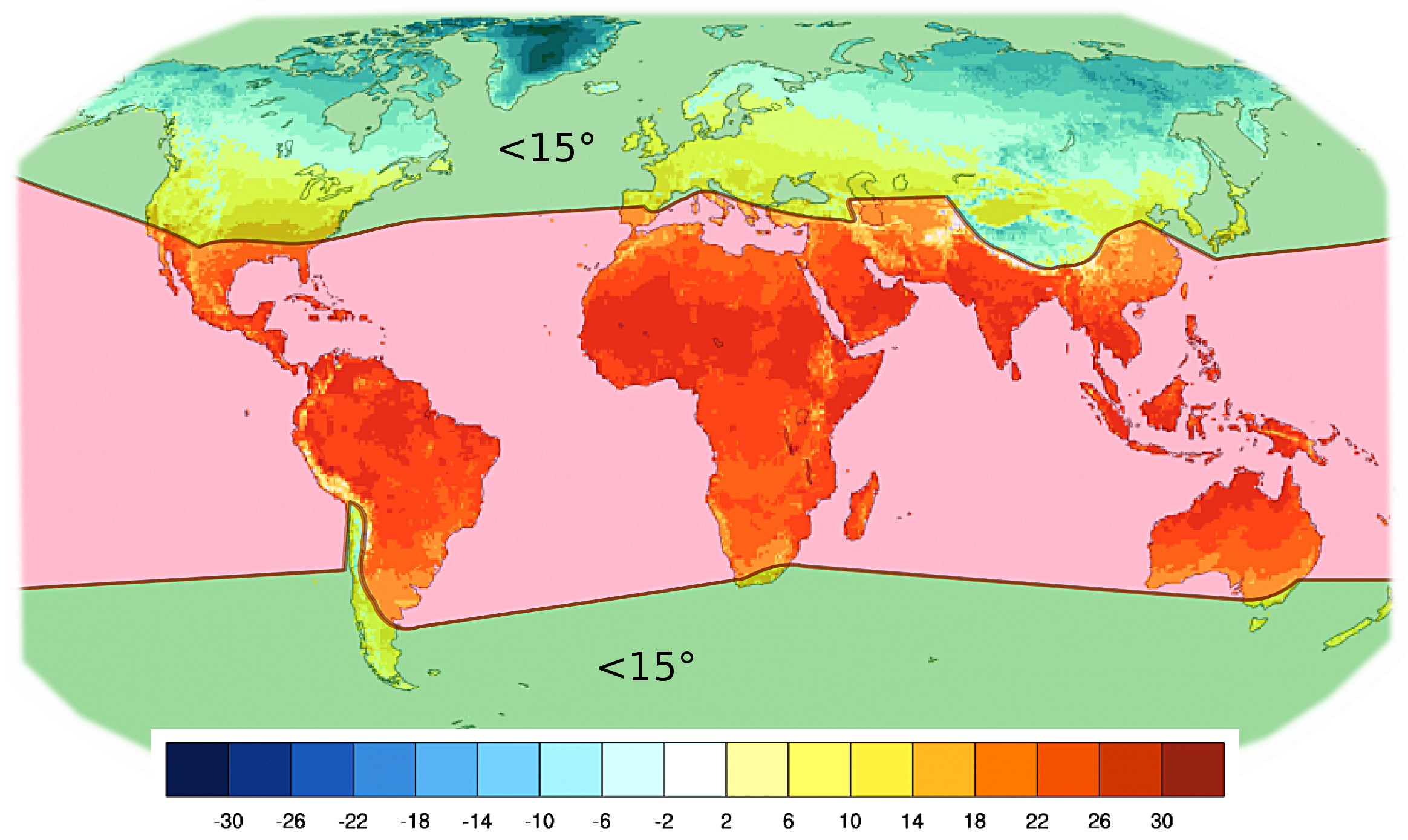
Figure 3: The annual mean temperature 1951 - 1980, divided into areas above and below 15°C. Based on (Schneider 2017)
The Arrhenius equation of exponential increase of rate with temperature also applies to diffusion processes, such as the penetration of pollutants and plasticisers through materials and the separation of barely compatible mixed substances, notably plastics and polymers of mixed molecular weight. Separation of component substances of artefacts is observed in cool storage, as discussed later. The concentration of internally generated organic acid vapours in the air of museum stores is strongly inhibited by low temperature. (Ryhl-Svendsen, Jensen, and Larsen 2014)
The general description of the influence of RH on materials which react with water is through the law of mass action, which was established in the nineteenth century by Guldberg and Waage. The reaction rate for many hydrolysis reactions of polymers is proportional to the activity of water vapour, which is identical to the RH, defined as the actual partial vapour pressure of water, divided by the partial vapour pressure over a flat water surface. This ratio is quoted as a percentage in the conservation literature but as a ratio less than one, called the water activity, in most other sciences.
There is therefore only a proportional improvement in durability through reducing the RH, compared with the exponential effect of reducing the temperature. The RH needs to be very low to give significantly better preservation. However, there are other influences of water activity, particularly on ionic corrosion reactions on surfaces, which rely on the presence of a thin aqueous liquid film on the surface. A curious example of this is in the paper by Tennent and Baird (Tennent and Baird 1985) which describes the immunity of washed carbonate shells to acetic acid corrosion from a wooden cabinet, compared with the crumbling of shells contaminated by seawater evaporates, which form a deliquescent surface liquid film at RH above about 25%.
Michalski, from a wide ranging literature survey, derived the empirical relationship that the rate of reaction is set by water activity raised to the power 1.3 (Michalski 2002). However, there are materials which suffer sudden consequences of the RH passing through a critical value. Rock salt will endure for ever at any RH below 76% but rapidly dissolves in atmospheric water vapour at a higher RH. Indeed, mineral collections, and mineralised ceramics, are the most sensitive of museum objects to even brief variations in RH which pass through the deliquescence points of evaporite minerals. Wall paintings also suffer episodes of damage closely related to a movement of RH through a specific value.
Despite the diversity of materials and structures in museum collections, the elegant graphical visualisation pioneered by Don Sebera (Sebera 1994), based on the Arrhenius equation and the law of mass action, gives a useful synopsis of the dependence of deterioration processes on the two main environmental influences (figure 4).
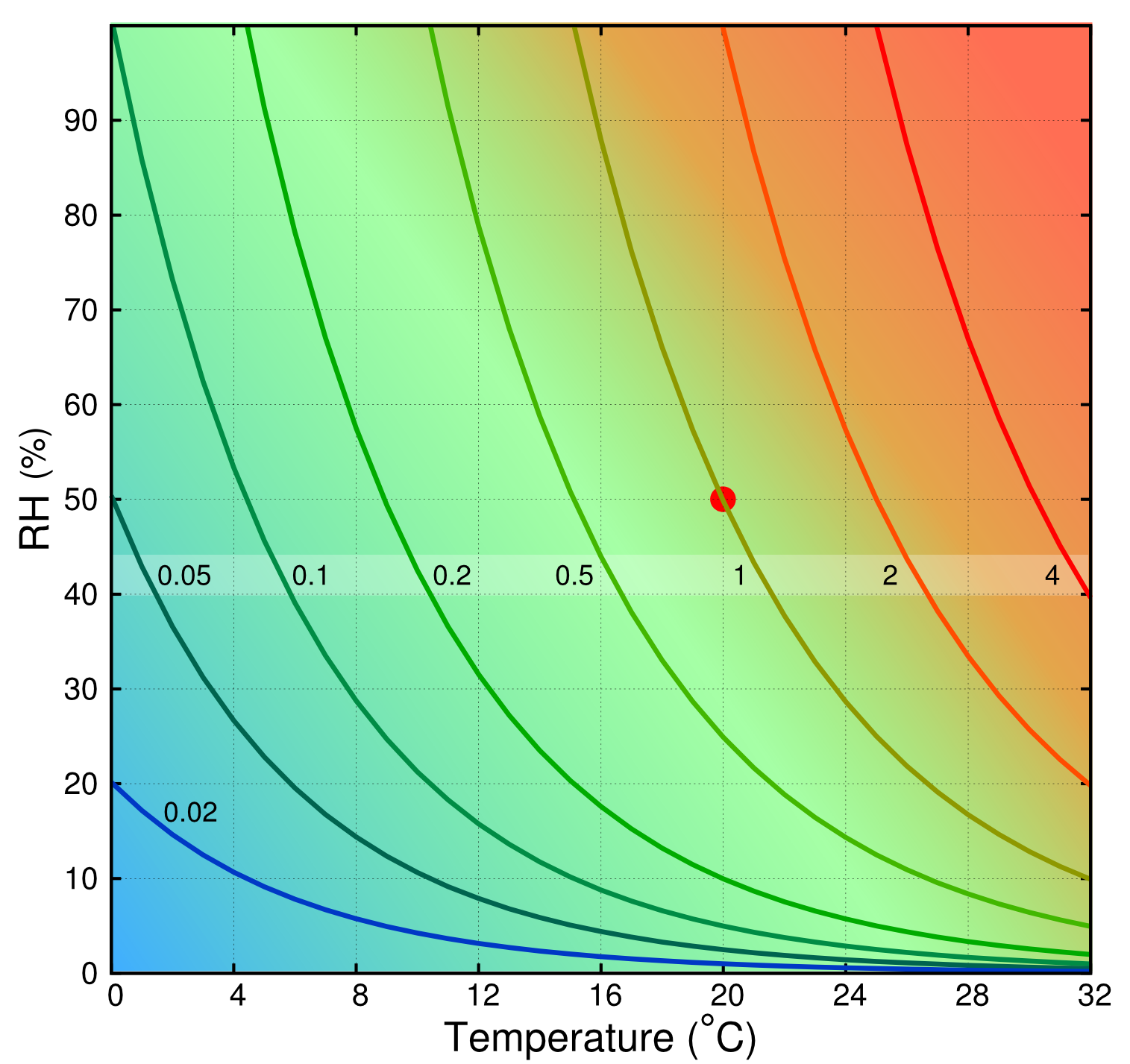
Figure 4: Each curve represent combinations of temperature and RH which cause a given relative reaction rate. The trend towards horizontal of the lines at very low RH shows that very low RH is very protective, the more vertical lines at high RH indicate that reducing the temperature is the best path to preservation, with little advantage from dropping the RH within the middle range. The curves are inspired by Don Sebera’s isoperm concept (Sebera 1994). They are based on an activation energy of 100 kJ/mol and hydrolysis reactions involving one water molecule.
The building can be of lightweight construction. The vital requirement is a U-value (heat conductivity of the walls and ceiling) around 0.1 W/m2·K. This value, combined with the heat capacity of the stored materials and of the floor, will nearly suppress the daily temperature cycle and considerably reduce the influence of longer periods of unusual ambient temperature. A lower U value risks accumulating heat from lighting, equipment and people. It also risks maintaining a too high winter temperature, with consequent low RH. The balance between minimising heat gain from the environment yet allowing heat loss from people and equipment within the building is discussed in (Padfield 2010). The calculation is best done by computer modelling. (Bøhm and Ryhl-Svendsen 2011; Christensen, Janssen, and Tognolo 2010)
The main heat buffer is the floor and the ground beneath it. The U-value of the concrete floor slab is about 0.4 W/m2·K but the heat transmission into the earth below is difficult to calculate for the semi-infinite thickness of earth. This estimate is done by computer modelling and the result, for the coldest and the warmest month is shown in figure 5. This shows that the ground under a building of reasonable size for a museum store behaves thermally as part of the building, after a year or two of acclimatisation, during which the presence of the building gradually alters the pattern of underground temperature previously established by open exposure to the weather. The heat flow is negligible below 3 m, so there is no need for insulation at depth. Surprisingly, there is also no need for insulation at the edge of the building, where there is a transition from the open field response to the under-building response.
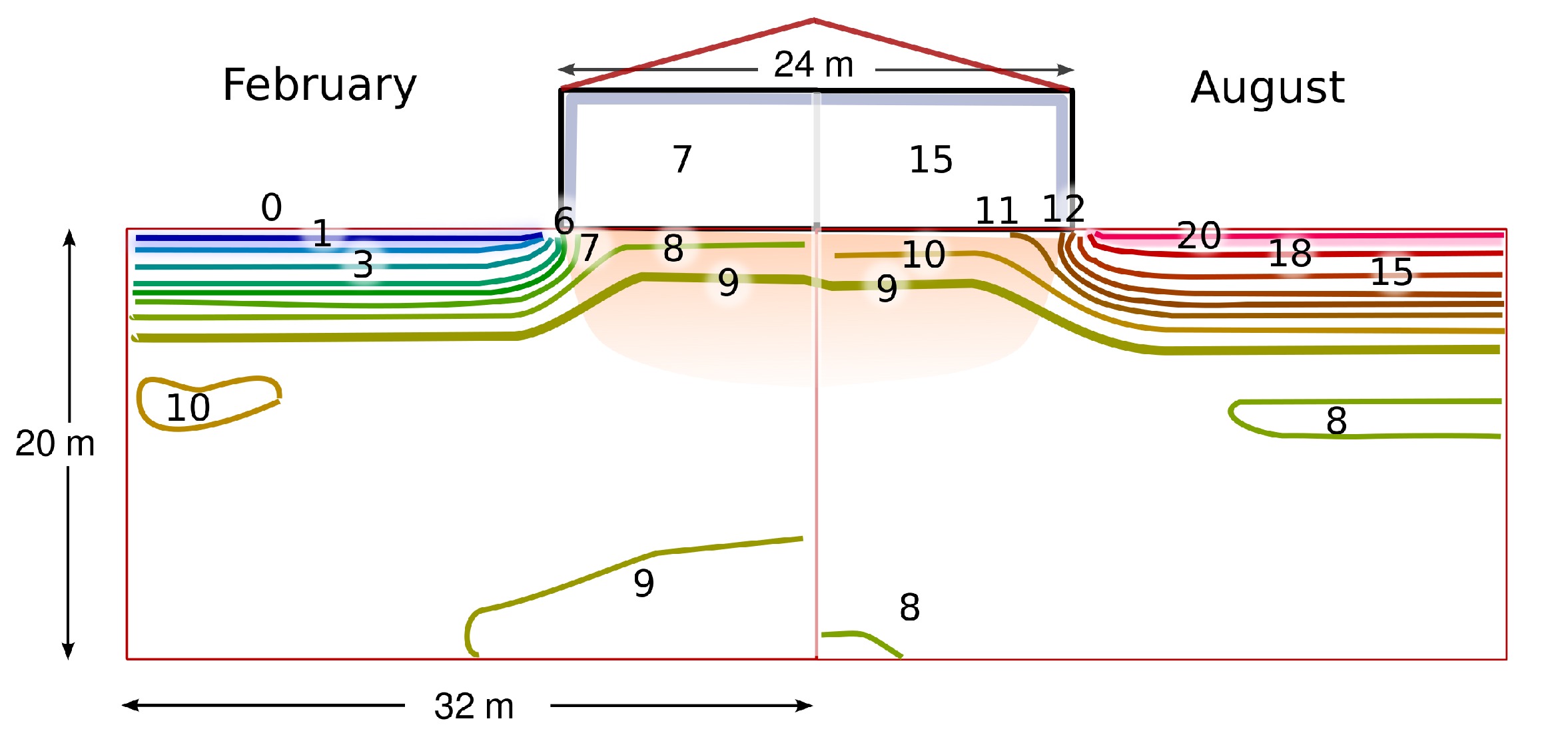
Figure 5: A computer model of the temperatures (in degrees celsius) below ground in February (on the left half) and in August, in Ribe, Denmark. The slab of ground under the building has a much reduced temperature cycle through the year and functions as a heat sink for the building. The heat flow through the contour for 9°C is negligible, as shown by the wide spacing of the contours at depth. No insulation is needed. The calculation is by Benny Bøhm (Bøhm and Ryhl-Svendsen 2011).
The temperature regime maintained by this simple construction is a smooth annual cycle with an amplitude about half of the running average temperature outside. The upper graph in figure 7 compares the measured temperature gradients in the ground below the building and beside it. The lower graph continues the measurement up through the building. This is a six metre high space without any subdivision other than the stacks of objects on shelves. The vertical temperature gradient never reaches three degrees.
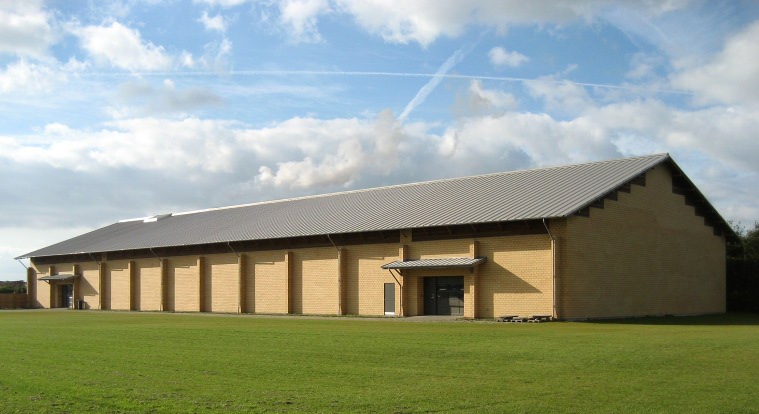
Figure 6: The museum store in Ribe, south west Denmark.
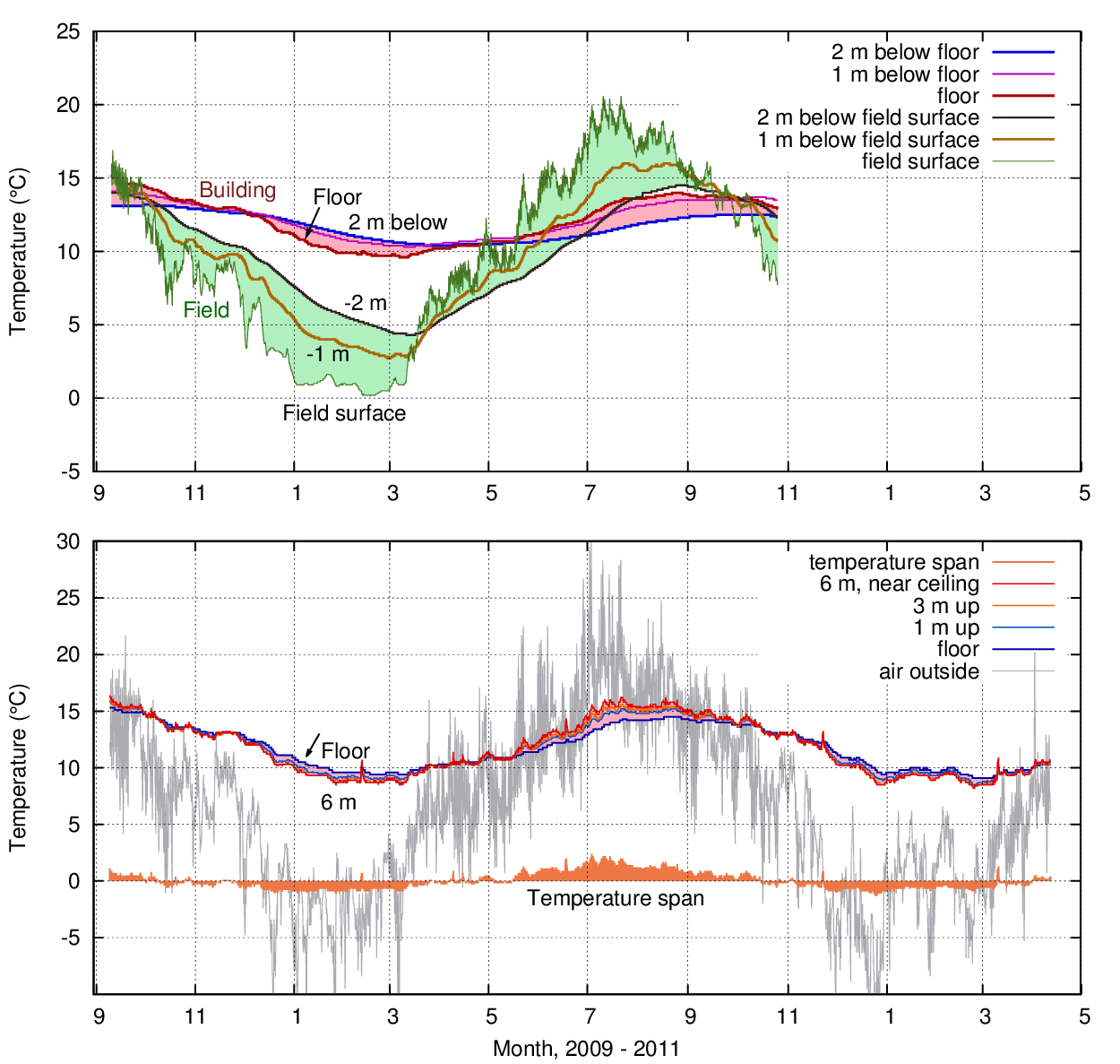
Figure 7: Top: the measured temperatures in the ground beneath the Ribe store and below an open field beside the building. Bottom: the temperature at various heights within the building.
Since only dehumidification is installed, the winter temperature must be approximately correct for keeping the RH moderate as outside air slowly infiltrates. In Europe this means holding a February temperature approximately 7 °C above ambient. This assumes an outside RH close to 90%, which will moderate to about 50% RH as it infiltrates and warms. The wall insulation thickness can be adjusted to ensure this temperature difference as a running average.
To widen the scope of this article beyond southern Scandinavia, we show an example from south of the Alps. Figure 8 shows the likely course of the outside and inside temperatures and the dehumidification need, for each month in the climate of Turin.
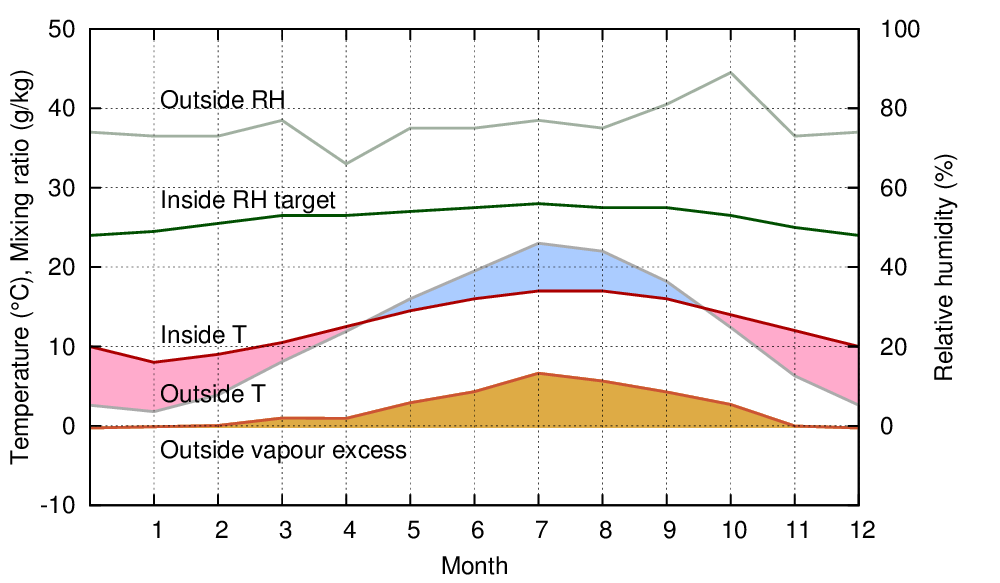
Figure 8: The dehumidification needed in a museum store in Turin. The inside temperature is estimated for a single storey insulated building set directly on earth. The target RH is set to a gentle annual cycle to avoid the need for winter humidification and to reduce the energy needed for summer dehumidification. Outside climate data are from the EnergyPlus database (EnergyPlus 2017).
No energy is required in winter, though the RH will drop below 50%. During the summer, when the inside temperature is on average below ambient, dehumidification will be needed, so the RH target can be set at any moderate value. For economy, it is allowed to rise in figure 8. The annual energy use is proportional to the air exchange rate, which in practice can be limited to 0.05 per hour. To keep the moisture content of materials constant, there should be a slight fall in RH as the temperature decreases, as can be deduced from the pattern of sorption isotherms in figure 12.
Figure 9 shows a measured example of such a floating temperature regime, from the more northern climate of Ribe. The graph also shows the water vapour concentration difference between inside and outside. Throughout this article, water vapour concentrations are expressed as the mixing ratio, in grams of water per kg of dry air. This relatively unfamiliar unit is used because the mixing ratio in a packet of air does not change as it warms or cools on penetrating the building envelope, though it does expand or contract. The more usual unit, g/m3, varies with temperature in an isolated, constant pressure environment containing a constant number of water molecules.
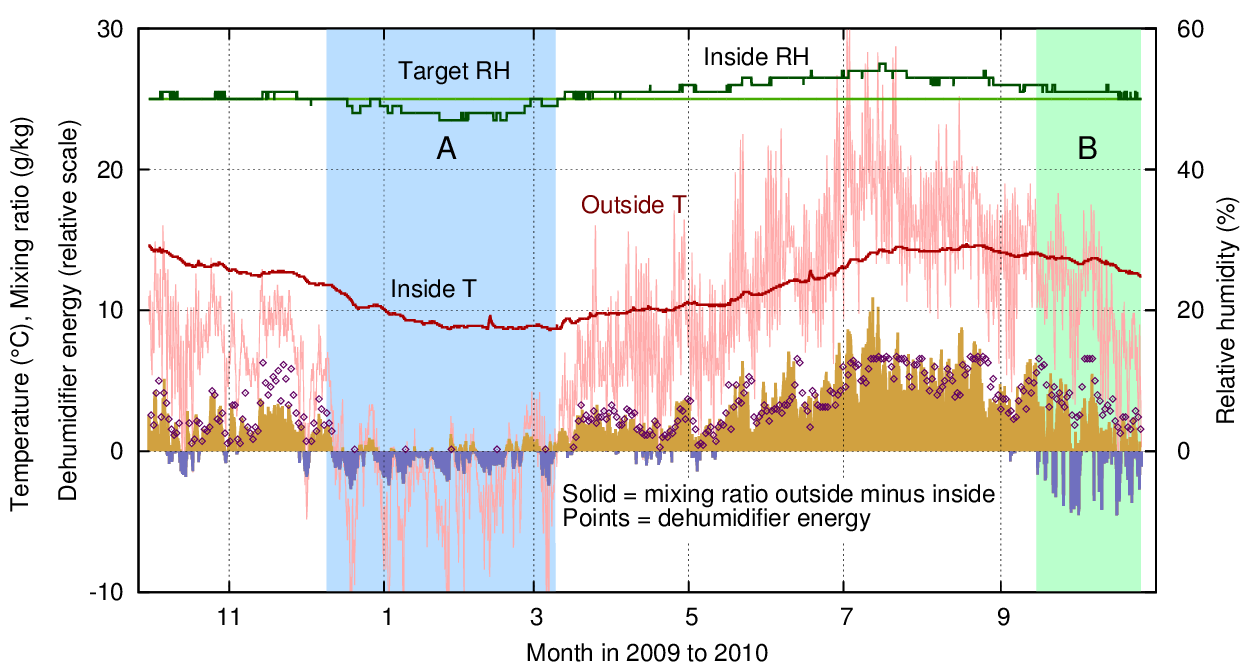
Figure 9: Dehumidification of the Ribe store. In winter (shaded area A), no humidification is available, so the RH drops a few points below the 50% set point. In July, the dehumidifier is working at full capacity and the RH increases just a few percent above the set point. In autumn, period B, the dehumidifier is still operating, even though the outside air often contains less water vapour than inside, so pumping outside air would be more efficient.
The energy use for dehumidification follows the same pattern as the difference in mixing ratio inside and out. The air exchange rate in the Ribe store is 0.03 per hour.
In figure 9 one notices that there is dehumidification continuing during the period shaded ‘B’ while at the same time the outside air has a lower water vapour content than that inside, as shown by the downward pointing blue spikes. During this period it would be more efficient simply to pump outside air in, rather than dehumidify recirculated inside air. A further point of interest is at the beginning of the graph, where dehumidification is continuing to force the RH down to the target 50% while we know that during the following few cold months, the interior RH will inevitably fall below 50%, so the control algorithm could with advantage look at a calendar to ease up on the dehumidification at the approach of winter, even if the RH is above the set point.
The effectiveness of pumping is well displayed in the record from the small archive of the Arnamagnæan Institute of Copenhagen University (figure 10).
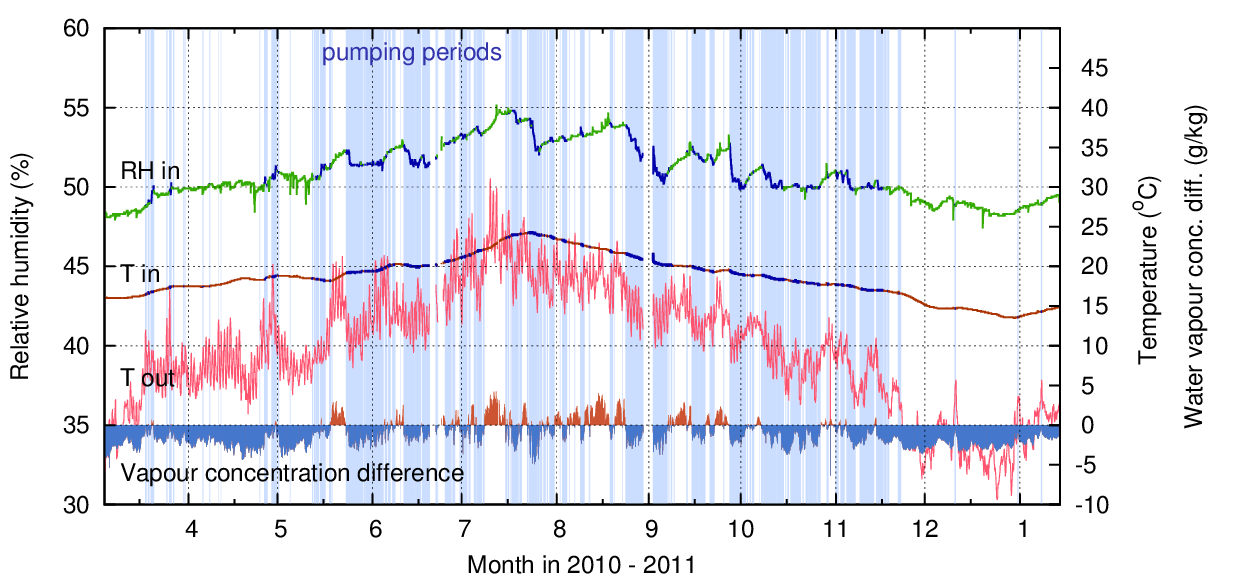
Figure 10: The small archive of the Arnamagnæan Institute of Copenhagen University has no dehumidifier, instead, it pumps in outside air when the vapour content will push the inside RH towards the target 50%. (Padfield et al. 2018)
The effect of pumping to reduce the RH is shown by the steeply descending blue sections of the inside RH trace during periods of pumping. However, the temperature is not nearly so strongly affected, because the heat capacity of the air is much less than that of the stored materials in their concrete-walled store.
In the European climate, with its annual temperature cycle but much smaller variation in RH, the period of maximum dehumidification demand is when the temperature is over ten degrees, in summer. If the RH target is 50%, the dewpoint is close to zero. Most of the low energy museum stores use absorption dehumidifiers. These work at any temperature and can provide a low RH. However, they are not energy efficient when compared with condensation dehumidifiers, which are nearly always used in air conditioning installations.
Condensation dehumidifiers use around 1 kWh per kg of water collected. At 10°C and 50% RH the dew point is zero celsius. This means that the condensing surface must be below zero and thus be covered with ice. There has to be intermittent defrosting of the condenser, but such a brief interruption is entirely smoothed out by humidity buffering by the stored materials.
Absorption dehumidifiers operate at around 2 – 3 kWh/kg. The smaller efficiency is compensated at low temperature, and particularly at low RH, where the condensation dehumidifier has to cool the air a lot to achieve the dew point, thus losing efficiency. The measured energy consumption of absorption dehumidifiers in real conditions in several museum stores has been reported by Ræder Knudsen and Lundbye (Knudsen and Lundbye 2017).
There is scope for further improvement in low energy climate control. Recently designed stores use less than one kWh/m3 per year. In comparison, an archive built to a constant climate, controlled by air conditioning, uses about 25 kWh/m3 per year (Ryhl-Svendsen et al. 2010).
Pumping outside air when it is of suitable vapour content is the most efficient form of RH control, but for long periods the weather prevents it. It is not necessary in winter, provided the annual temperature cycle in the store is well matched to the annual cycle of the local climate.
The summer demand for dehumidification coincides with the period of high solar energy, so conveniently matches the output of solar voltaic panels. The lack of energy during the short nights will not result in significant daily variation in RH provided the air exchange rate is low.
Both temperature and humidity buffering rely on very little exchange of heat and moisture with the outside air. Unintentional ventilation should be only through small leaks and the opening of doors by people. Frequently used doors should be protected by an air lock, with paired doors set far enough apart for a trolley and a person to fit between. Emergency doors and doors occasionally used for moving large objects do not need this protection.
Air movement is often advocated as a means to hinder mould growth. However, the connection between air velocity and mould growth is indirect: in old buildings the circulation of air is vital to ensure a uniform temperature and thus prevent high RH in cold corners. In a purpose built store, the insulation should be placed to ensure that a uniform temperature is maintained without forced air movement. The temperature difference between inside and outside will be smaller than in a dwelling, further reducing the risk of uneven temperature.
A portion of fresh air injection is also advocated in general air conditioning practice. This is needed to provide oxygen and to remove carbon dioxide from human metabolism. In a store with only occasional human presence, there is no need for ‘fresh’ air, together with the outdoor pollutants it contains. Another reason for bringing in outside air is the perceived need to ensure a slight over-pressure within the building, to prevent entry of uncontrolled air and flying insects. Modern buildings can be made nearly airtight and insects, flying or walking, cannot be avoided without clean-room discipline.
However, stores vary in the frequency of visits by people, so it is always advisable to install a carbon dioxide detector and an airway from the outside, to override the general principle of minimising the air exchange rate, when many people are present.
Museum stores cannot completely avoid using modern materials which release volatile substances, also the stored objects will contribute their own volatile components, long after they were constructed and sometimes as a consequence of conservation treatment. Therefore it is sensible to consider installing a pollutant filter in the recirculating dehumidification system. Absorption dehumidifiers remove many pollutants from the air (Wolfrum, Peterson, and Kozubal 2008). One can expect condensation dehumidifiers to absorb soluble pollutants on their cold and wet condensing surface. However, the dehumidifiers only operate intermittently, so adding a separate absorber in the recirculation path is sensible. At the low winter temperature when dehumidification is inactive, the production, diffusion and reaction of internally generated pollutants is low. For a museum store in Vejle, the total organic acid concentration was 1,2 and 4 ppb (parts per billion by weight) at temperatures 12, 14 and 16 degrees respectively. (Ryhl-Svendsen et al. 2012). For a museum store in Ørholm the concentrations were 19, 47 and 106 ppb at temperatures 11, 19 and 21 degrees. In the Copenhagen Music Museum store there was a 6 – 43 ppb rise from 8 to 24 °C. (Ryhl-Svendsen, Jensen, and Larsen 2014)
Humidity buffering does not affect the amount of energy used to dehumidify. However, buffering does improve the resilience of the indoor climate to short but extreme climate events, and it allows intermittent dehumidification, optimised for the availability of cheap and sustainable energy.
A small air exchange rate is necessary for effective humidity buffering. This alone will even out the dehumidification demand and thus allow less powerful equipment, with limited potential to cause catastrophe through malfunction. In archives, consisting largely of paper and cardboard boxes, the buffer capacity is so large that it takes several weeks for significant RH change to occur in the event of equipment failure.
Computer simulation programs, called HAM (heat and moisture) models are used for modelling the performance of outer walls but are not yet good at modelling the diffusion of water molecules within a collection of diverse objects.
One important consequence is that designers choose to ignore the influence of the stored objects on their micro-climate and thus provide far too powerful mechanical control. Neglect of the useful influence of the stored objects is also reinforced by a myth that it is unethical to involve artefacts in stabilising their own local climate. The reversible exchange of water molecules between a material and its adjacent air continues at RH equilibrium at very nearly the same rate as when the material is responding to a changed RH in the adjacent air, so objects buffer their surrounding space, whether one wishes them to or not.
The recent French National Archive building in Pierrefitte, Paris (Figure 20), was designed explicitly to function without involving the stored materials in the air conditioning calculations (Bonandrini 2017). However, for archives in particular, with their holding of paper documents, the buffering by the paper provides an enormous stability to the RH.
Padfield and Jensen (Padfield and Jensen 2011) attempted to improve the reliability of involving the stored materials at the building design stage. They proposed a simple way to estimate the buffer capacity of an unbuilt space. They attribute to each stored item, a packet of papers for example, a buffer value (B-value) which is equal to the volume of space whose RH would respond in exactly the same way as the RH in equilibrium with the paper when subjected to the same injection of infiltrating water vapour.
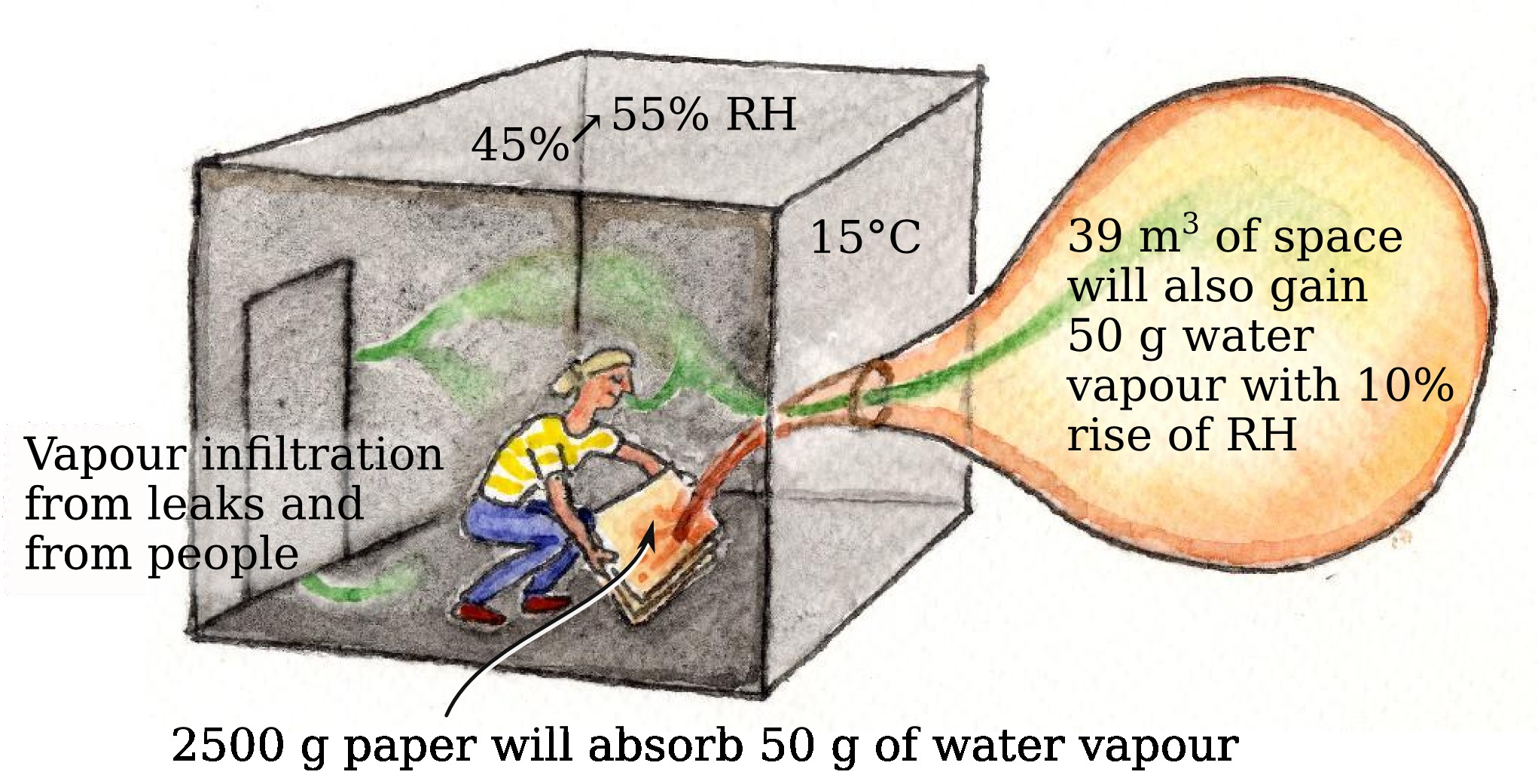
Figure 11: The buffer bubble. A single packet of printing paper, A4 × 60 mm thick, weighs 2.5 kg. If the RH rises by ten percentage points, at 15 °C, 50 g of water vapour will be absorbed from the surrounding space. This is the same amount of water as would have to enter a 39 m3 space to give the same 10% rise of RH. The reaction to water vapour of the paper bundle and the space are equivalent.
In the example shown in figure 11 a standard packet of A4 printing paper exposed to a 10 % RH rise has an equal water absorption as would raise the RH by 10% in 39 m3 of space. This is the B–value of the packet of paper. If the room volume were 125 m3, infiltrating moist air will distribute its water vapour within a ‘virtual volume’ of 164 m3 of empty space. So the expected RH change will be reduced by about one third. This is the buffer effect of the package. For the designer, the packet can now be ‘removed’, and its climatic influence replaced by the increase in volume of the space. The thermal behaviour is calculated from the actual room construction while the hygrometric response to air leakage, and human breath, is calculated for the enlarged volume of empty space.
The B–value for an item is calculated on the basis of a material property, usually the sorption curve of a cellulosic material, but it actually belongs to the individual package. This makes it well suited to integration with inventory databases and programs used to optimise the shelf stacking in museum stores, for example (Criollo and Bres 2017).
Let us now fill the archive room so that about one fifth of its volume (25 m3) is papers. This will be about 6760 packages. The B–values are additive, so the total B–value of the archive contents is 263,500. This value so completely dwarfs the actual volume of the room that infiltration at a typical rate of 0.05 changes per day will take many months to materially alter the RH.
Yet many paper archives have air conditioning that reacts within seconds to signals from sensors within the room activated by the varying temperature, which causes a small rise in RH with rising temperature (as can be seen from the cotton sorption isotherms in figure 12). This busy adjustment uses energy uselessly.
The humidity buffer effect can be measured in existing buildings with absorbent content by injecting a measured weight of steam, from a kettle, and measuring the consequent rise in RH, while allowing for the inevitable small leakage during the equilibration period.
The B–value is temperature dependent because the sorption of water into paper is only slightly affected by temperature whereas the vapour concentration in space diminishes rapidly with falling temperature. The change from 15 °C to 10 °C will increase B for the stack of paper from 39 to 54.
The B–value is also time dependent, because the calculation above assumes that all the paper participates in the buffering process. In reality, the half time for the stack of paper to come half way to equilibrium with a changed ambient RH is about three weeks. This is unimportant in an archive which has such a vast buffer reserve that only the outer layers of the packet need to participate in the process. The theoretical buffer capacity, based on the published sorption curves for cotton, can be used for calculation.
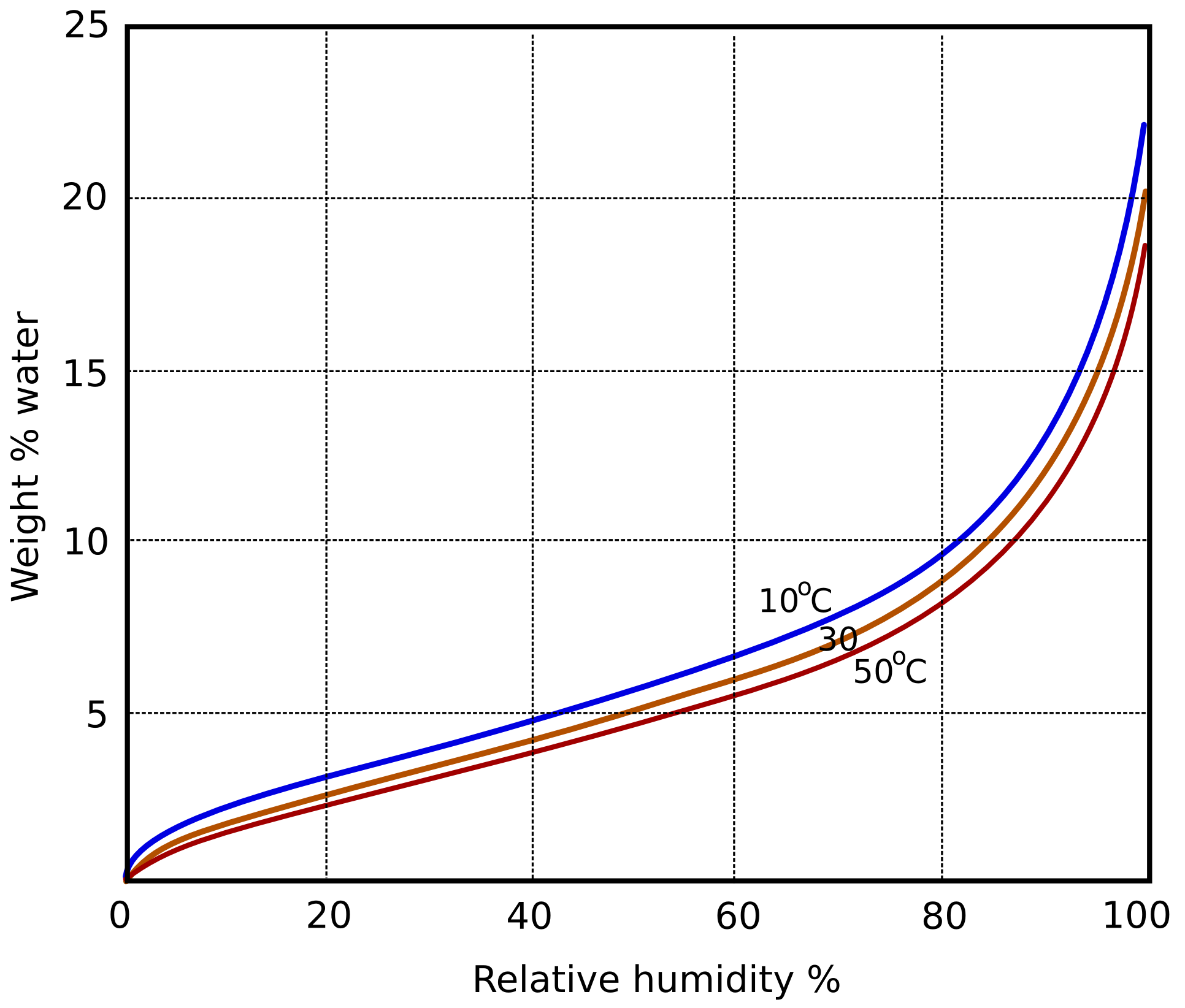
Figure 12: The sorption curves of cotton at various temperatures. Redrawn from data from Urquhart and Williams (1924)
Paper archives have a very high humidity stability but stores containing non-absorbent materials such as metal objects have a low total of B–values. These stores benefit from humidity buffering built into the structure, in the form of moisture reactive walls and ceilings. (Padfield and Jensen 2011; Padfield, Jensen, and Ryhl-Svendsen 2012)
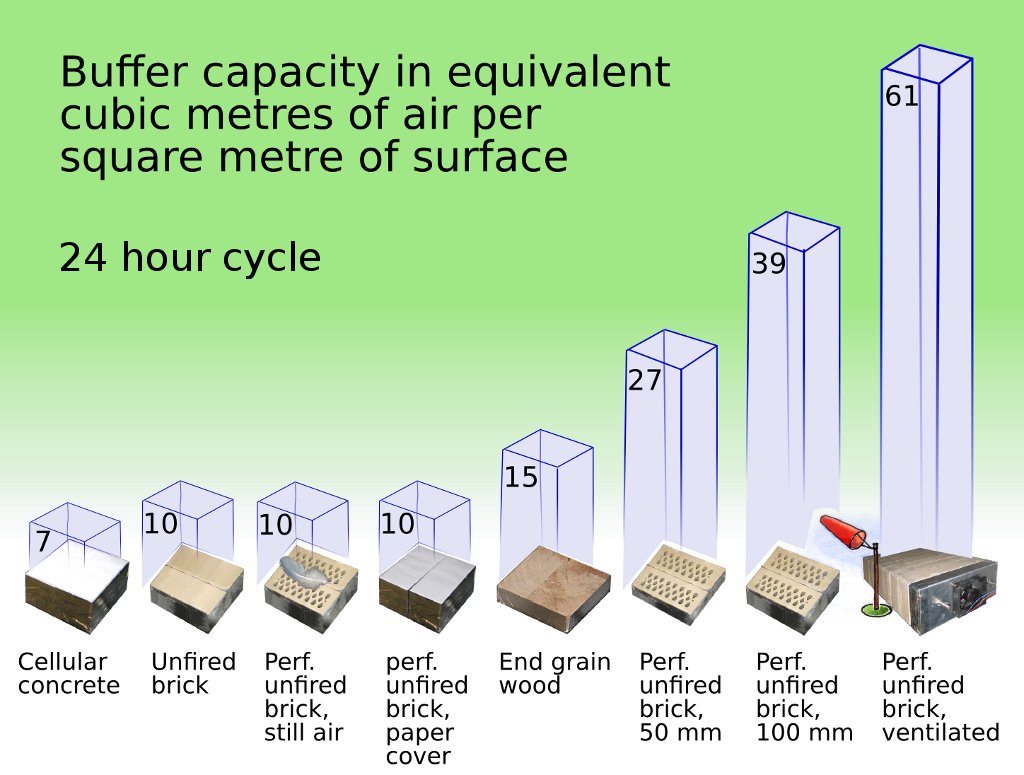
Figure 13: The B-values of some building materials, visualised as columns of space above a square metre of material surface. For walls, the equivalent volume per square metre of wall surface is the most useful measure to combine with the B–values of the stored objects.
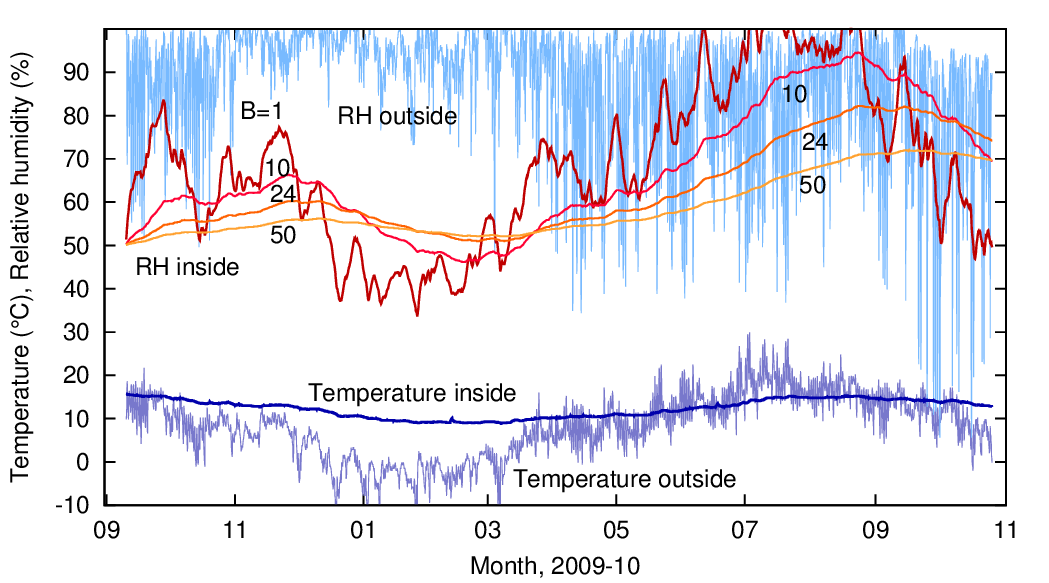
Figure 14: The Ribe store modelled without dehumidification, but with varying degrees of humidity buffering. The air change rate is 0.03 per hour. The RH is arbitrarily set to 50% at the beginning of the period. Note that the RH is higher at the end of the period, emphasising that in the humid north European climate dehumidification is necessary in the long run. Passive buffering alone can never be sufficient.
One can see the beneficial effect of even modest B–values in figure 14, which is a computer simulation of the course of the temperature and RH in the Ribe store if there were no active humidity control.
A measured example from a small room partly lined with perforated unfired brick is shown in figure 15, with a best fit B–value simulation (Padfield, Jensen, and Ryhl-Svendsen 2012).
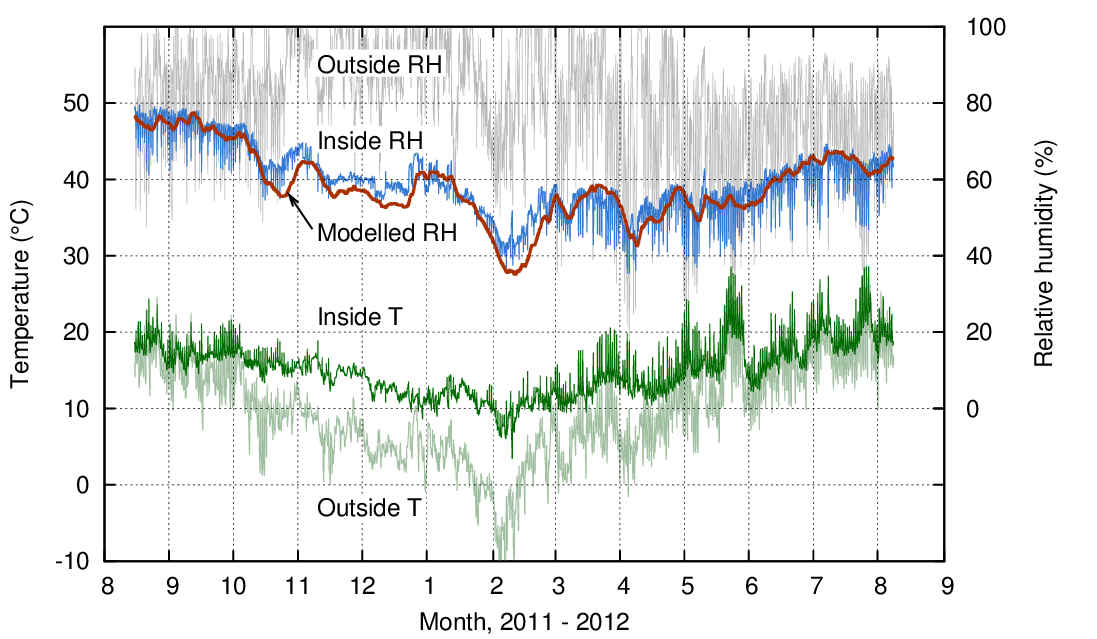
Figure 15: The measured and modelled relative humidity in a room partly lined with perforated unfired brick. The B–value is 100 but the buffer cannot respond to the rapid, temperature induced variation in RH measured at the centre of the room when sunlight enters on many afternoons. Merging a model with B–value 25, for the rapid response of the brick surface increases the accuracy of the simulation.
For lightly buffered spaces it is over-optimistic to use the B–value based on the material sorption at equilibrium, which is the usual published value. A rapid change in the space climate, from sunlight through windows for example, as in figure 15, will only influence the surface millimetre of the stored objects, so the effective B–value for these transient episodes will be smaller. If the ideal, theoretical room B–value is less than 100 it is realistic to reduce it to 25 before making the predictive calculation.
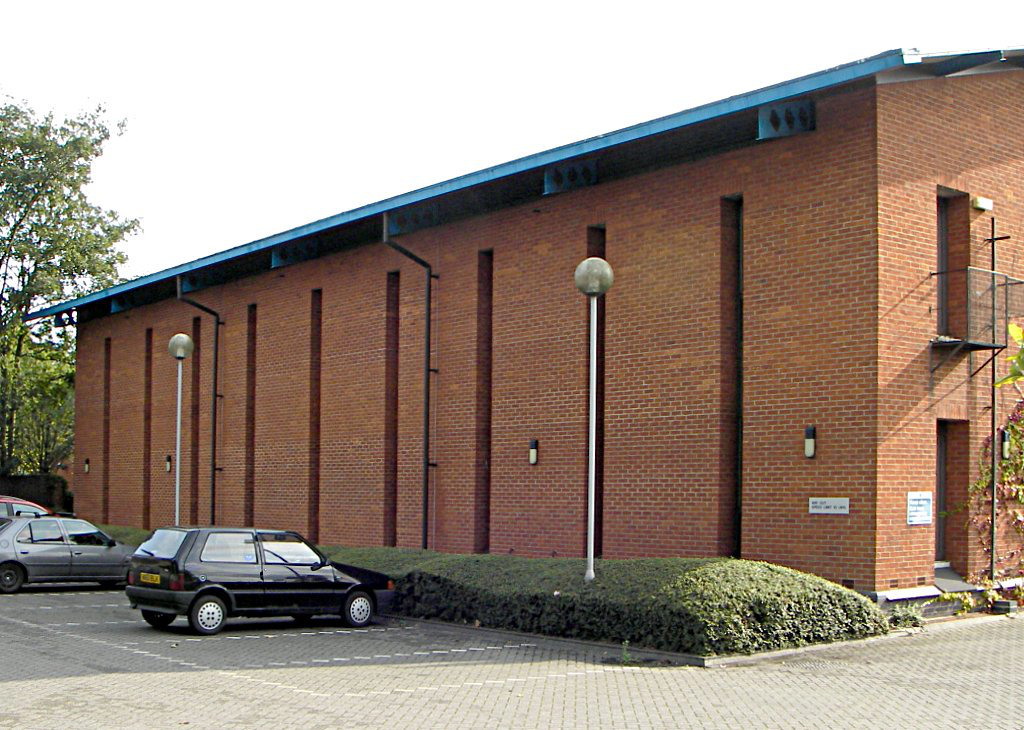
Figure 16: The Suffolk Record Office, Ipswich, UK. Opened in 1990.
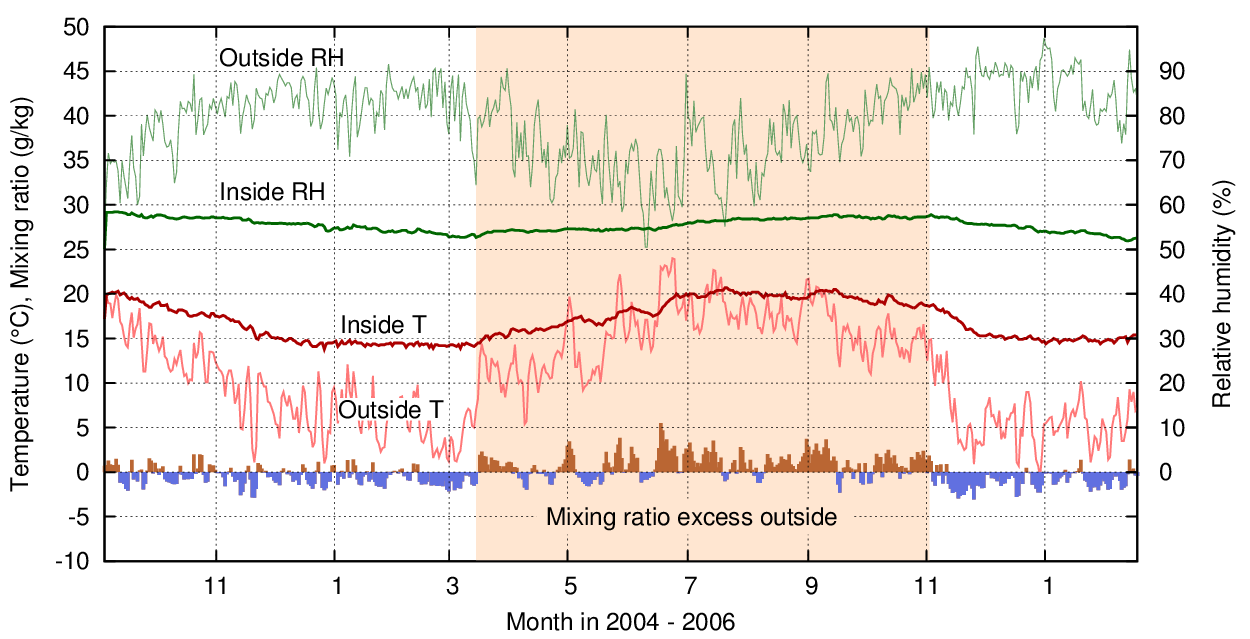
Figure 17: The RH in the Suffolk Record Office rises just a few percent points over the summer months even though the mixing ratio shows an almost continuously higher concentration of water vapour outside, which would raise the interior RH as it leaked in. The humidity buffering by the abundant paper holds the summer RH from rising significantly. In this building there is no dehumidification ever; the moderate annual RH is attained by winter heating to a minimum 15°C.
The measured influence of humidity buffering in a well filled paper archive is well displayed by the performance of the Suffolk Record Office in Ipswich UK (figure 17). In this building there is no dehumidification. The annual average RH within is kept below the annual average outside by winter heating alone. This would, without the buffer effect, push the winter RH well below the 55% annual average. The extent of the disequilibrium between the water vapour content of the interior space and the air outside is shown by the difference in the mixing ratio, the lowest trace on the graph. The summer mixing ratio outside is nearly always higher than that inside, meaning that infiltration will tend to increase the indoor RH, by adding to the water vapour concentration. This does happen, but only to a modest extent. Conversely, the winter shows a higher mixing ratio inside, predicting that infiltration will lower the RH, which it does, but only by about four percentage points. Unfortunately, we do not have the air exchange rate for this building, which was opened in 1990. From its construction one would estimate about 0.2 per hour.
There was no explicit RH control in this building. The thermostat set to 15 °C indirectly controlled the annual average RH, so it had even simpler climate control than the dehumidification already described. However, this archive is now fully air conditioned, because the upper room occasionally exceeded the temperature limit set in a now superseded British Standard for Archives (BSI 2000).
The Suffolk archive operates with an annual average temperature above the outside average, but still below the human comfort zone in winter. Another archive that operates in the same way is the Arnamagnæan archive of Copenhagen University (Padfield et al. 2018). It does not even have a thermostat to control its RH, which is maintained by a balance between heat flow from the always warm interior of the building and the heat flow through the outside walls. Fine control is however achieved by pumping, as shown in figure 10 above.
Winter warming uses more energy than dehumidification in a new building with a low air exchange rate, but it may be a useful solution for busy archives. A chart comparing energy use by the techniques discussed in this article is given by Larsen (Larsen 2018).
RH control by regulating the temperature according to the signal from a hygrostat (commonly called “Conservation Heating”) is catastrophic in a tightly packed store with low air exchange, because a rise in RH will be reinforced by raising the temperature (Padfield 1996).
Archival quality ‘conservation heating’ is best achieved by a thermostat set at around 14 °C (depending on the local climate), combined with considerable humidity buffering but no active humidity control. This eliminates summer heating above ambient. Figure 18 shows the modelled performance of the Ribe store if it were heated in winter rather than dehumidified in summer. When the B-value exceeds 250, the RH remains safe, though varying, through the year. A B-value of 1000 provides RH constancy comparable with full air conditioning. There is no need even to measure the RH; the thermostat is the only control required.
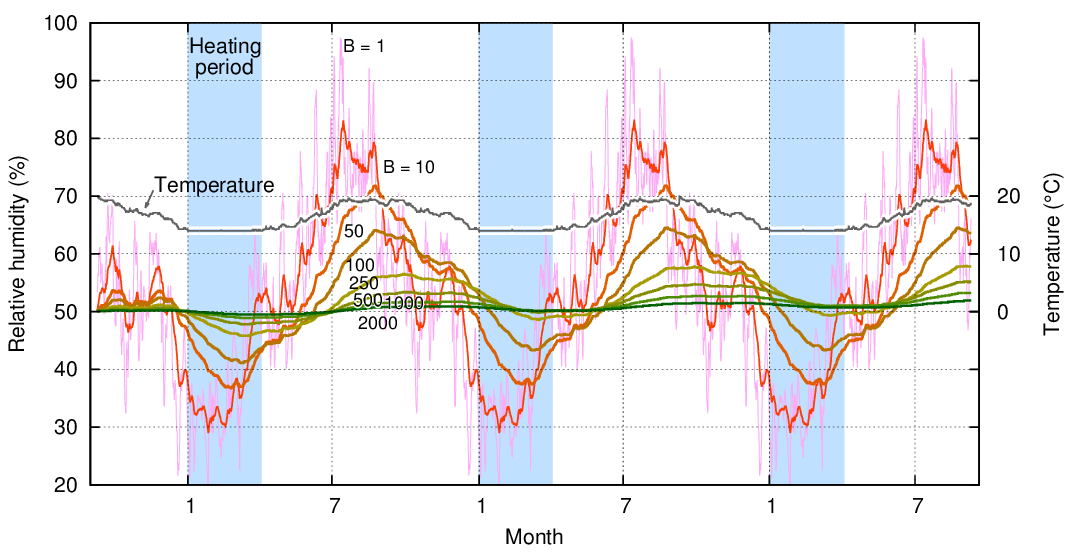
Figure 18: The modelled course of the RH for various B-values, if the Ribe store were heated to a constant 14 °C in winter and not dehumidified at all. A B-value of 250 will stop a dangerous RH arising at any time of year, a B-value of 1000 will give a very stable RH throughout the year. In this graph a period of three identical years of outside climate is modelled to show how the heavily buffered store is still slowly increasing in RH at the end of the period. It will reach about 55 % after many years. Conversely, raising the winter temperature by half a degree will keep the RH close to 50% for ever.
Most artefacts have been made for use within the human comfort range of temperature, 20 °C to 25 °C. Few artefacts have a composition designed with the primary aim to endure as museum objects in long term cool storage. Cool storage slows many chemical degradation reactions but it also exposes the mutual insolubility of chemicals which mix well at room temperature. The cool storage facility at Vejle in Denmark provided an example of separation of chemicals from the polyvinylchloride bodies of dolls (Lauridsen et al. 2017). The process reversed on warming and the authors conclude that cool storage is, on balance, still a good environment for long term durability.
Efflorescence of pure beeswax seals below 12°C was reported by Novotná and Dernovšková (2002), though this phenomenon also occurred, slowly, at room temperature.
A consequence of the freely drifting temperature model of museum storage is that the store will often be at a lower temperature than the study room. The dew point of the study room, that is the temperature at which water will condense onto a surface, will typically be about 10 °C. This means that an object taken from the store in late winter, at 9 °C will suffer from surface condensation if suddenly exposed to the study room air. However, this danger can be entirely removed by enclosing the object in an airtight and lightly insulated container and leaving it to warm up close to room temperature before opening the enclosure. However, the risk can be almost entirely eliminated by allowing the study room RH to fall in winter, to around 40%, when the dewpoint will be about 6 °C. A temperature difference between store and study room is often cited as a reason for keeping stores close to human comfort temperature but the discussion should be about the balance between the slowing of deterioration of an entire collection through a nearly perpetual (but not constant) low temperature, set against the convenience to the researcher retrieving an individual object for study.
The same temporary insulated enclosure is necessary on returning an object into the cool store, to prevent condensation on the object’s immediate surroundings, such as a film can, where condensation can dribble down into the film itself. (Padfield 2002)
As environmental standards become less rigid, archives relax their environmental specification, but reliance on orthodox air conditioning continues. One reaches a point where air conditioning is used when almost the same specification can be attained without it. An example is the Pierrefitte archive in Paris (Bonandrini 2017). This is fully air conditioned to a specification of 16 °C – 24 °C and 40% – 57% RH.
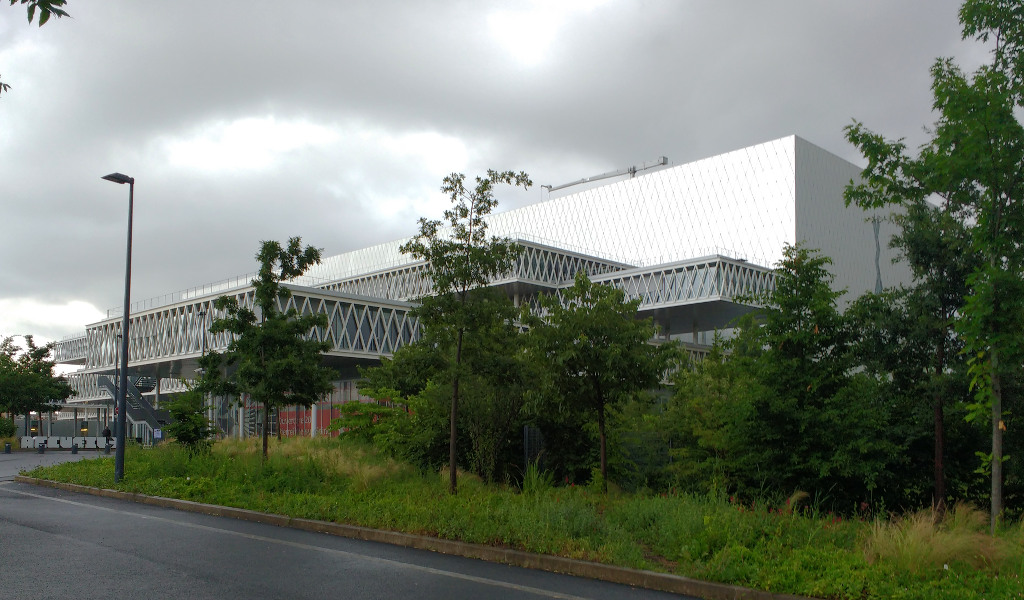
Figure 19: The Pierrefitte archive of the National Archives of France.
However, its performance is so close to that of the Suffolk archive that a very small change of operating point would make air conditioning unnecessary. Figure 20 for the Suffolk archive, has the design limits for Pierrefitte superimposed. The Suffolk climate lies very nearly within these limits.
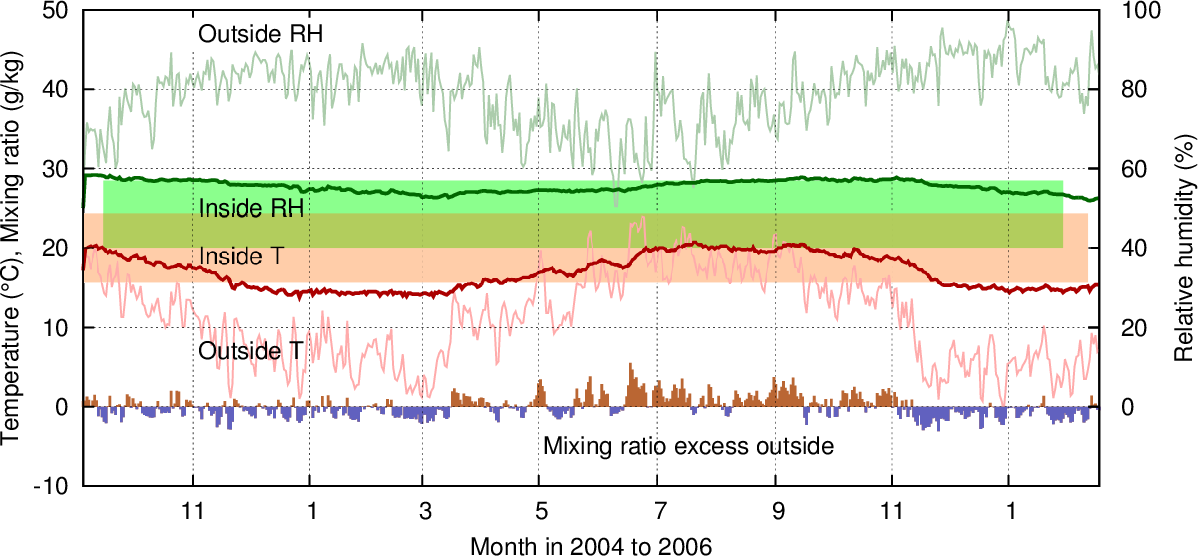
Figure 20: The graph for the Suffolk archive in figure 17 is here overlaid with the Pierrefitte climate limits.
The corresponding graph for a typical room in the Pierrefitte archive is shown in figure 21.
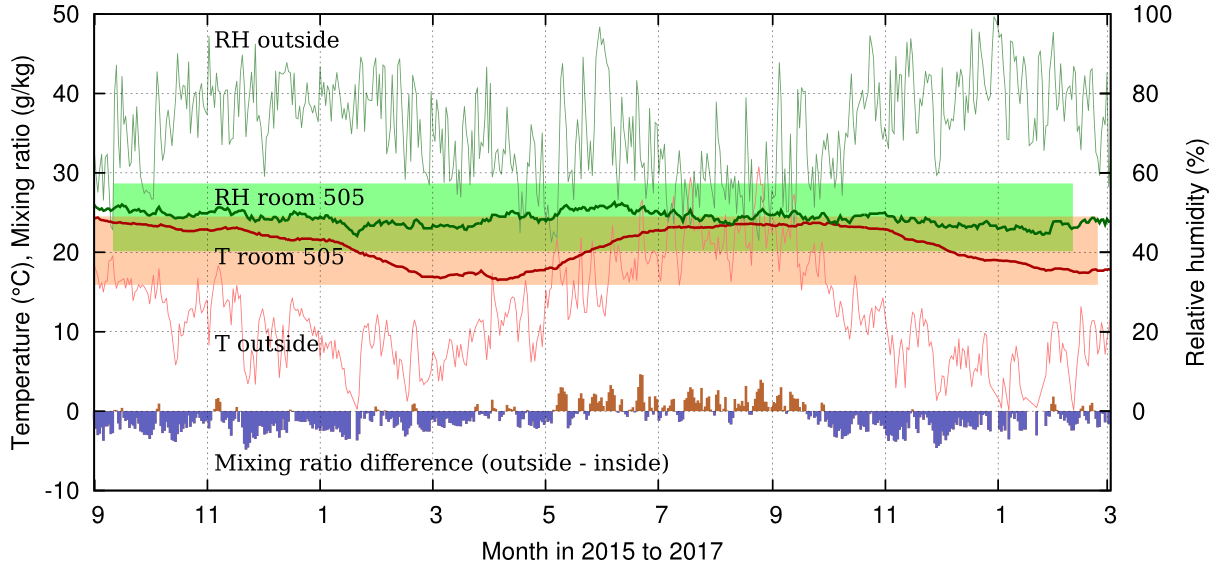
Figure 21: The interior climate in the Pierrefitte archive of the National Archives of France. The specification is the shaded area. The imbalance in mixing ratio forces winter humidification.
The mixing ratio shown in the lowest trace is not in balance, there is less water vapour inside in winter compared with the excess outside during the summer. This means that humidification will be necessary to keep the RH moderate. De-humidification is also installed, because the design is based on an empty building without humidity buffering. The design also calls for a deliberate air exchange, rather than the best attainable airtightness.
Let us now make a small alteration to the operating conditions of the Pierrefitte archive, as shown in figure 22. We lower the set point of the RH to make the mixing ratio balance over the year. This means that the RH set point can now be abandoned as a controlling parameter, only the temperature cycle needs to be controlled. The combined influence of the temperature and the humidity buffering by the stored papers will maintain the specified RH in a room without active air exchange with the outside.
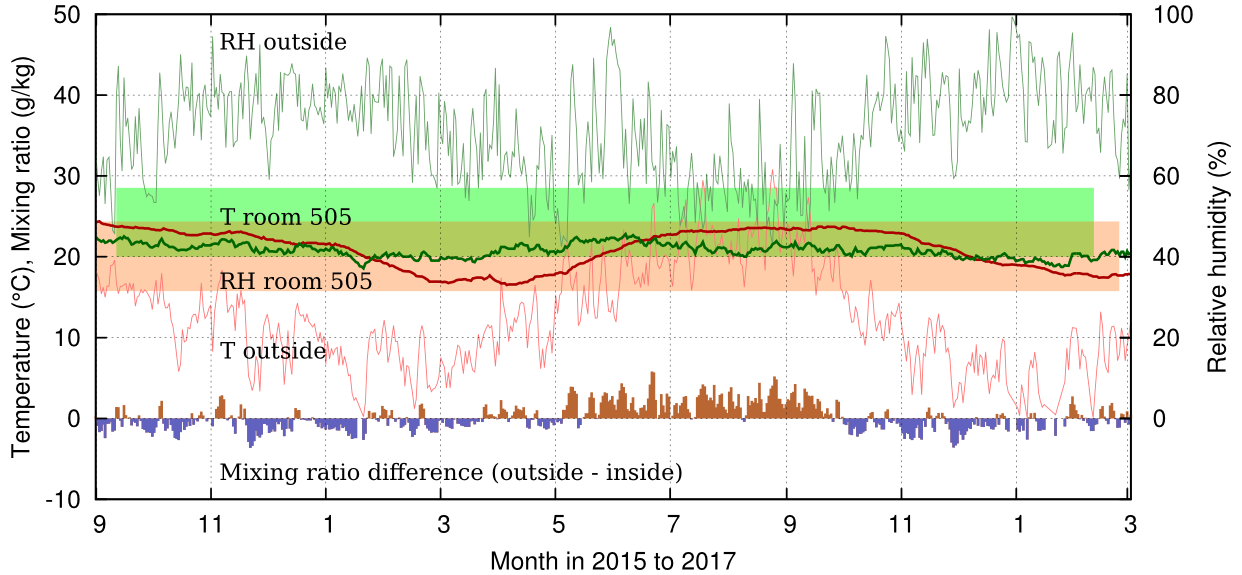
Figure 22: If the RH is set close to the lower limit of the Pierrefitte specification, the mixing ratio balance becomes equal, summed over the year. This would make air conditioning unnecessary. Only the temperature need be controlled, the paper providing buffering as in the Suffolk archive.
If the designers of the Pierrefitte archive had permitted themselves to take account of the environmental buffering by the stored materials, they could have avoided air conditioning, yet achieve the stability of the Suffolk archive in the same way – by controlling only the winter temperature. The low RH would have improved the durability of the paper, but the alternative, of reducing the temperature to give a RH around 55%, would have been even more beneficial.
The Suffolk archive is now air conditioned, because its upper room occasionally got warmer than the standard permitted; a standard that has now been superseded. the Pierrefitte archive is air conditioned because it was explicitly designed to hold a specification as an empty building, knowing that it was also destined to be filled with archived material.
Standards have become less strict over the last decade, because of ethical misgivings over the use of energy in air conditioning, and the need to set a good example in reducing carbon dioxide emission. However, there is a hidden implied regret that this inevitably results in a less than optimal storage climate. The ethical dilemma is rapidly abating, as sustainable energy becomes available, and occasionally abundant. Furthermore, museum storage can be entirely self sufficient, with just a portion of the roof covered by solar voltaic panels.
Several influential standards still exclude the temperature range which is natural to our climate control system, jumping from a 15 °C lower limit straight to cold storage. The argument for excluding the intermediate range rests mainly on the separation of organic mixtures in waxes and plastics, and the increasing stiffness of paint.
The influential standard developed by the American Society of Heating, Refrigerating and Air-Conditioning Engineers (ASHRAE 2015) allows several categories of preservative climate ranging from AA to D. AA is explicitly stated to be the best. It has a temperature control of ± 2 °C with a seasonal set point adjustment of ± 5 °C. The RH variation is ± 5 %. (Michalski 2007). That climatic range is achievable by our low energy storage system. Unfortunately, the temperature limits, even for archives, are set at 15 °C to 25 °C, while the standard itself admits that this is bad for chemically unstable materials. Our system, over a large range of temperate climates, will have a temperature span between 8 °C and 16 °C. This requirement puts us entirely out of the AA to C range of allowed climates. The ASHRAE chapter cites increasing brittleness of acrylic and oil paint with decreasing temperature but also predicts vastly increased chemical durability at low temperature. Other standards also set exact temperature limits. The British Standards Institute (BSI) document PD5454–2012 (BSI 2012a) cites the risk of phase separation in pure beeswax seals (Novotná and Dernovšková 2002) as reason to assert a minimum temperature for “high value collections” at 14 °C. This can be achieved by winter warming in a humidity buffered store but cannot be achieved with a temperature freely cycling about the annual average. It also reduces the durability of the far greater bulk of documents without pure wax seals.
There are signs of a change of approach to standards, in which fixed temperature limits are not required to be revered as absolute limits. The British Standards Institute issued, at the same time as PD5454, an advisory document PAS198–2012 (BSI 2012b) which takes a different line, introducing the concept that the curator should be given the information to make her own judgement about storage conditions, based on the individual collection.
The admirably simple ISO standard 11799:2015: “Storage of library and archive materials” (ISO 2015) is less prescriptive. Its warmest category is 16 °C - 23 °C , rated as ‘fair’. 8 °C - 16 °C is rated ‘good’.
One might think that the variety of standards available would allow considerable flexibility in the specification, but archives in some countries have to obey a particular standard to be certified as fit to hold documents. Let us hope that future standards will allow environmental specifications that accommodate both the nature of the collection and its local climate.
There will always be a moment in specifying a storage space when the architect and engineer will ask for an exact specification for the required indoor climate. PAS198 passes that responsibility to the curator or manager, but it is a technical decision which requires knowledge of the deterioration processes of the collected items and the frequency of retrieval, as well as knowledge of the local climate and an understanding of air conditioning techniques. This decision has a huge influence on the cost and complexity of museum buildings, yet the gulf in training and technical language between conservators and engineers leads to conservative decisions which are over-influenced by the apparent certainties offered by strict standards.
There is a good case for opening up the standards debate, in the form of a wiki-style process, hosted by a conservation institution rather than by a standards institution. The standard would evolve by successive corrections and would, at some point be fixed for a five year period, to give practical certainty to architects and engineers. Meanwhile the accumulation of evidence and predictions for the optimal environment for the well being of artefacts of various materials and states of disrepair will continue.
There is now abundant evidence from measured buildings, for the effectiveness, simplicity and cheapness of low energy air conditioning for museum stores and archives. The preferred option is to allow the temperature to drift freely in a gentle cycle centred on, but with a span well within, the outdoor temperature cycle. This diminished annual cycle is enforced by the thermal inertia of the ground beneath the building, supplemented by the heat capacity of the stored materials and of the building itself, and by thermal insulation of the walls and roof.
In the temperate zone, summer dehumidification will be needed. Given sufficient humidity buffering by a combination of sorption by the stored materials and a nearly airtight building, this process can be intermittent, driven by the availability of solar radiation or by wind power delivered through the grid.
This climate control consumes less than a tenth of the energy required by air conditioning set to fixed values of temperature and humidity. However, there is also a benefit in the lower average temperature and consequently reduced deterioration rate.
Some busy archives will choose to run at a temperature nearer to the human comfort zone. This also can be achieved relatively cheaply by winter heating to approximately 15 °C, combined with humidity buffering by the archived papers and by good airtightness, including air locks for frequent access routes. This will ensure that the vapour infiltrating with outside air in summer will not raise the indoor RH more than five percent points. If the internal buffering is not quite adequate, the peak RH can be moderated by intermittent pumping of outside air when, by chance of the weather, it has a water content that will tend to reduce the interior RH towards its target.
Current environmental standards do not take account of the possibility of varying the specification according to local weather patterns. Many standards claim to encourage energy saving initiatives but still set arbitrary limits to temperature, particularly, without consideration that occasional, or even permanent, excursions beyond the set span will not cause detectable damage to artefacts.
The further evolution of museum environmental standards should be conducted in a more scientific and open access manner, by the preventive conservation profession, released from the bureaucratic processes and arcane language favoured by standards organisations.
Climate data for the Suffolk Record Office are from Dominic Wall. Climate data from the Pierrefitte archive are from Bruno Bonandrini. Data from the Ribe museums store were collected by the National Museum of Denmark under a grant from the Danish Ministry of Culture.(Ryhl-Svendsen et al. 2012)
ASHRAE. 2015. “A23. Museums, Galleries, Archives, and Libraries.” In HVAC Applications. American Society of heating, refrigeration and air conditioning engineers.
Bøhm, Benny, and Morten Ryhl-Svendsen. 2011. “Analysis of the Thermal Conditions in an Unheated Museum Store in a Temperate Climate. on the Thermal Interaction of Earth and Store.” Energy and Buildings (43): 3337–3342.
Bonandrini, Bruno. 2017. “Le Batiment de Conservation Des Archives.” In Les Nouvelles Rencontres de La Conservation Preventive, edited by A. Gall-Ortlik, 81–105.
BSI. 2000. “BS5454:2000, Recommendations for the Storage and Exhibition of Archival Documents.” Standard. British Standards Institution.
———. 2012a. “PD5454:2012 Guide for the Storage and Exhibition of Archival Materials.” Standard. British Standards Institution.
———. 2012b. “PAS198:2012, Specification for Managing Environmental Conditions for Cultural Collections.” Standard. British Standards Institution.
Christensen, Jørgen Erik, Hans Janssen, and Barbara Tognolo. 2010. “Hygrothermal Performance Optimization of a Museum Storage Building.” In Performance of the Exterior Envelopes of Whole Buildings XI International Conference. Florida, USA, 1:68–71.
Criollo, Andrea, and Christophe Bres. 2017. “Évaluation Volumétrique d’une Collection: L’informatique au Service de La Conservation Préventive.” In Les Nouvelles Rencontres de La Conservation Preventive, edited by A. Gall-Ortlik, 149–169.
EnergyPlus. 2017. energyplus.net/weather. Online service.
ISO 11799. 2015. “Information and documentation – document storage requirements for archive and library materials”. Technical report, International Standards Institution.
Knudsen, Lise Ræder, and S. R. Lundbye. 2017. “Performance of Danish Low-Energy Museum Storage Buildings.” In ICOM-CC 18th Triennial Conference Preprints.
Larsen, Poul Klenz. 2018. “Humidity Control in Historic Buildings in Denmark.” In Proceedings of the International Institute for Conservation, Conference, Turin.
Lauridsen, Clara Bratt, Lola Wøhlk Hansen, Theis Brock-Nannestad, Jesper Bendix, and Kim Pilkjær Simonsen. 2017. “A study of stearyl alcohol bloom on Dan Hill PVC dolls and the influence of temperature.” Studies in Conservation 66 (8): 445–455. www.tandfonline.com/doi/full/10.1080/00393630.2016.1206651.
Michalski, S. 2002. “Double the Life for Each Five-Degree Drop, More Than Double the Life for Each Halving of Relative Humidity.” In ICOM-CC, Preprints of the 13th Meeting, 66–72.
Michalski, Stefan. 2007. “The Ideal Climate, Risk Management, the ASHRAE Chapter, Proofed Fluctuations, and Toward a Full Risk Analysis Model.” In Experts’ Roundtable on Sustainable Climate Management Strategies, 19 pages. The Getty Conservation Institute. www.getty.edu/conservation/our_projects/science/climate/paper_michalski.pdf
Novotná, P and J Dernovšková. 2002. ``Surface crystallisation on beeswax seals". Restaurator, 23(4):256–269, 2002.
Padfield, Tim. 1996. “Low Energy Climate Control in Museum Stores – a Postscript.” In Proceedings of the ICOM-CC Conference, Edinburgh, 1:68–71. www.conservationphysics.org/woodstor/p_hall_01.php
———. 2002. “Condensation in Film Containers During Cooling and Warming.” In Proceedings of the Conference “Preserve, Then Show”. The Danish Film Institute, Copenhagen.
———. 2010. “Requiem for the Cologne City Archive.” www.conservationphysics.org/koeln/koeln01.php
Padfield, Tim, and Lars Aasbjerg Jensen. 2011. “Humidity Buffering of Building Interiors by Absorbent Materials.” In 9th Nordic Symposium on Building Physics, 1:475–482. www.conservationphysics.org/ppubs/humidity_buffering_building_interiors_nsb2011.pdf
Padfield, Tim, Lars Aasbjerg Jensen, and Morten Ryhl-Svendsen. 2012. “Humidity Buffering of Building Interiors – a Postscript.” www.conservationphysics.org/wallbuff/Bvalue_postscript2012.pdf
Padfield, Tim, Morten Ryhl-Svendsen, Poul Klenz Larsen, Mette Jakobsen, and Lars Aasbjerg Jensen. 2018. “The Climate Control of the Arnamagnæan Archive.” In The 16th Seminar on the Care and Conservation of Manuscripts. www.conservationphysics.org/arna/arnamagnaean-CC16.pdf
Ryhl-Svendsen, Morten, Lars Aasbjerg Jensen, and Poul Klenz Larsen. 2014. “Air Quality in Low-Ventilated Museum Storage Buildings.” In ICOM-CC 17th Triennial Conference Preprints.
Ryhl-Svendsen, Morten, Lars Aasbjerg Jensen, Benny Bøhm, and Poul Klenz Larsen. 2012. “Low Energy Museum Storage Buildings: Climate, Energy Consumption and Air Quality.” National Museum of Denmark. www.conservationphysics.org/storage/low-energy_museum_storage_buildings.pdf
Ryhl-Svendsen, Morten, Lars Aasbjerg Jensen, Poul Klenz Larsen, and Tim Padfield. 2010. “Does a Standard Temperature Need to Be Constant?” Meddelelser Om Konservering (1): 13–19. www.conservationphysics.org/ppubs/standard_temperature.pdf
Schneider, D. 2017. “Annual Mean Temperature 1951–80.” Online image. National center for atmospheric research. climatedataguide.ucar.edu
Sebera, Don K. 1994. “Isoperms: an Environmental Management Tool.” Published online only: cool.conservation-us.org/byauth/sebera/isoperm/
Tennent, Norman H., and Thomas Baird. 1985. “The Deterioration of Mollusca Collections: Identification of Shell Efflorescence.” Studies in Conservation 30 (2): 73–85. dx.doi.org/10.1179/sic.1985.30.2.73
Urquhart, A.R., and A. M. Williams. 1924. “Absorption Isotherm of Cotton.” J.Textile Inst.: 559–572.
Wolfrum, Edward J., Darren Peterson, and Eric Kozubal. 2008. “The Volatile Organic Compound (VOC) Removal Performance of Desiccant-Based Dehumidification Systems: Testing at Sub-Ppm VOC Concentrations.” HVAC&R Research 14 (1): 129–140. dx.doi.org/10.1080/10789669.2008.10390998

This work is licensed under a Creative Commons Attribution-Noncommercial-No Derivative Works 3.0 License.